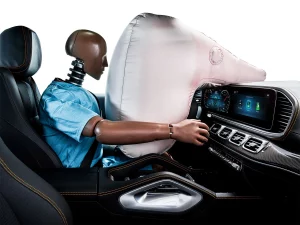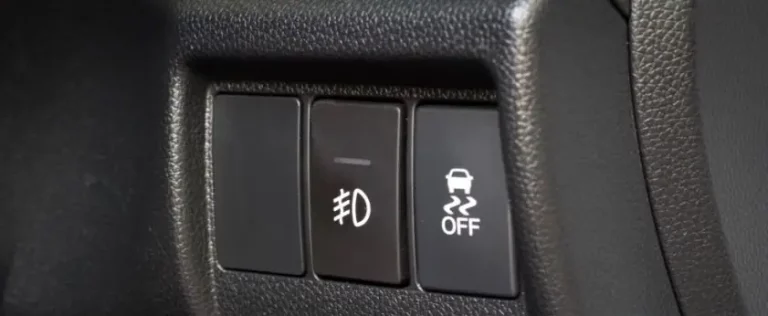How Do Car Airbags Work?
Automobile airbags can save lives because they can cushion passengers in an accident in milliseconds. But have you ever wondered how these unassuming bags manage to carry out such a difficult task? Don’t worry we are here to guide you in detail on how airbags work physics.

How Do Car Airbags Work?
Let’s study the current complexities of how they function.
Sensors:
These sensors are the brains of the airbag systems. Auto airbags are dependent on several sensors positioned thoughtfully all over the car. These sensors are made to recognize rapid fluctuations in velocity, acceleration, or deceleration—all of which point to the possibility of a collision. Typical sensor types include gyroscopes and accelerometers.
Electronic Control Unit:
The Electronic Control Unit (ECU), a specialized computer, receives the data gathered by the sensors and interprets it to decide whether the impact force is greater than a predefined threshold, triggering the deployment of the airbag.
When a car is moving, sensors positioned thoughtfully all over the place track changes in speed, acceleration, and deceleration. The ECU receives real-time data from these sensors, which frequently include gyroscopes and accelerometers. The ECU then makes use of intricate algorithms to decipher this data and determine the kind of effect that may have occurred. Certain thresholds are pre-programmed within the ECU to serve as requirements for airbag deployment.
These criteria take into account variables including the rate of deceleration, the collision’s angle and direction, and its total time. The ECU quickly examines the sensor data and initiates the airbag deployment procedure when it exceeds certain predetermined criteria.

Decision To Deploy:
The ECU takes into account variables including the vehicle’s speed, the impact’s direction and power, and occasionally even the occupants’ weight. The ECU initiates the airbag deployment cycle if it finds that the circumstances justify it.
Igniter And Inflator:
An airbag and an inflator make up the airbag system. A chemical mixture, often sodium azide (NaN3) and potassium nitrate (KNO3), is contained in the inflator. An igniter within the inflator receives an electric charge when the ECU provides the deployment signal, starting a chemical process that quickly creates nitrogen gas.
Airbag Deployment:
The airbag inflates due to the nitrogen gas produced by the chemical reaction, resulting in its deployment in a matter of milliseconds. The airbag deploys by bursting out of its compartment and placing itself between the occupant and the interior hard surfaces of the car.
Location Of Airbags:
Modern automobiles come fitted with many airbags positioned thoughtfully throughout the vehicle. The driver’s dashboard, the front passenger dashboard, the side pillars, and the sides of the seats are typical places. Additionally, some cars include curtain airbags, which drop from the roof to shield the heads of passengers in side-impact crashes.

Controlled Deployment:
Modern automobiles come fitted with many airbags positioned thoughtfully throughout the vehicle. The driver’s dashboard, the front passenger dashboard, the side pillars, and the sides of the seats are typical places. Additionally, some cars include curtain airbags, which drop from the roof to shield the heads of passengers in side-impact crashes.
Seat Belts And Airbags:
When used in combination with seat belts, airbags work best. By keeping passengers restrained, seat belts assist to reduce the risk of a high-speed collision with the airbag. Airbags and seat belts work together to give a complete safety system in a car.
Deflation:
The airbag begins to deflate through venting holes after deployment, enabling the person to walk around and safely leave the car. The purpose of the deflation procedure is to lessen the possibility of harm from the airbag’s own force.
What Is an Automobile Airbag
An essential part of vehicle safety, an airbag in an automobile functions flawlessly to protect passengers during crashes. The intricate interaction between sensors and electrical control units is revealed when one understands how automobile airbags operate. The Electronic Control Unit (ECU) receives information from sensors positioned strategically throughout the vehicle to identify changes in velocity and deceleration in the event of an accident. The ECU, which functions as the airbag system’s brains, uses complex algorithms to evaluate the data and determine the kind and severity of the impact. The ECU quickly inflates the airbag with nitrogen gas when it determines that deployment is required.
This quick reaction creates a cushion of protection, reducing the power of contact and the chance that car occupants may be hurt. Car airbags are a marvel of accuracy and functionality, representing the pinnacle of engineering and modern technology used to improve road safety.
Why Airbags are Important In Your Vehicles
Vehicle airbags are an essential safety component that provides a vital first line of defense in the event of an unexpected collision. Comprehending the significance of airbags in automobiles, trucks, SUVs, and recreational vehicles highlights their function in reducing the likelihood of injuries to occupants. Together with seat belts, airbags offer a complete protective barrier in the case of an accident. Airbags absorb impact forces and quickly deploy to create a cushioning barrier between passengers and the vehicle’s interior, therefore lowering the risk of serious injury.
This safety feature is especially important for a variety of vehicle types, such as automobiles, trucks, SUVs, and recreational vehicles (RVs), as it improves overall occupant safety and makes driving safer. Purchasing airbag-equipped cars demonstrates a driver’s dedication to safety and emphasizes the vital role airbags play in saving lives in unanticipated traffic accidents.
Conclusion
To sum up, understanding how car airbags work reveals the complex but essential safety net included in contemporary cars. The interplay of sensors, the Electronic Control Unit (ECU), and the prompt airbag deployment exemplify an intricate ballet intended to save passengers in crashes. The accuracy with which impact forces are analyzed and the speed at which nitrogen gas is used to inflate airbags demonstrate the technological prowess committed to improving road safety.
Understanding how automobile airbags operate serves to emphasize how vital these devices are for preventing injuries as well as giving passengers an additional line of protection when traveling. The ongoing development of airbag systems in automobiles guarantees that all types of vehicles—from sporty SUVs to little sedans—are outfitted with a safety feature that is at the forefront of saving lives on the road.








One Comment